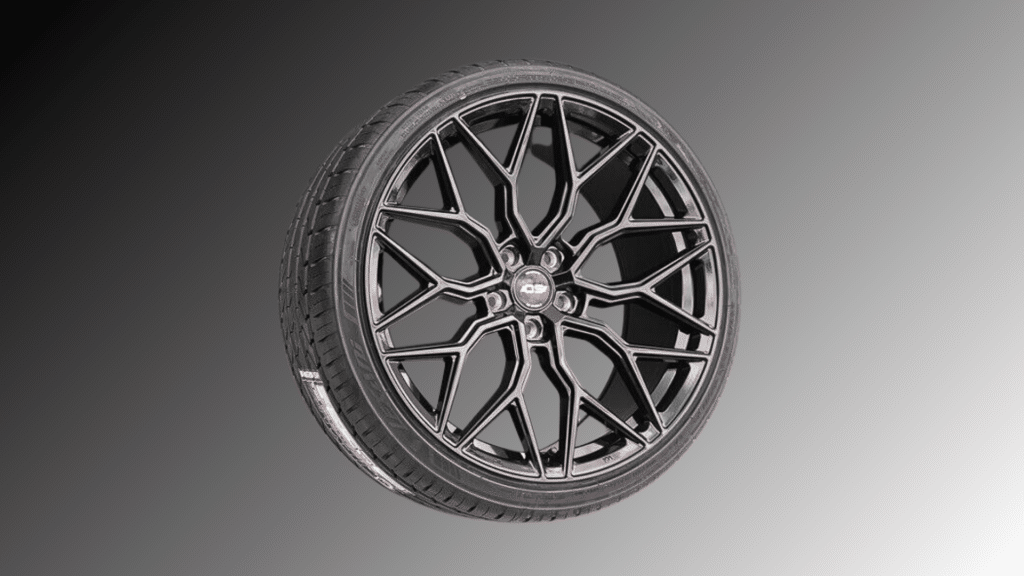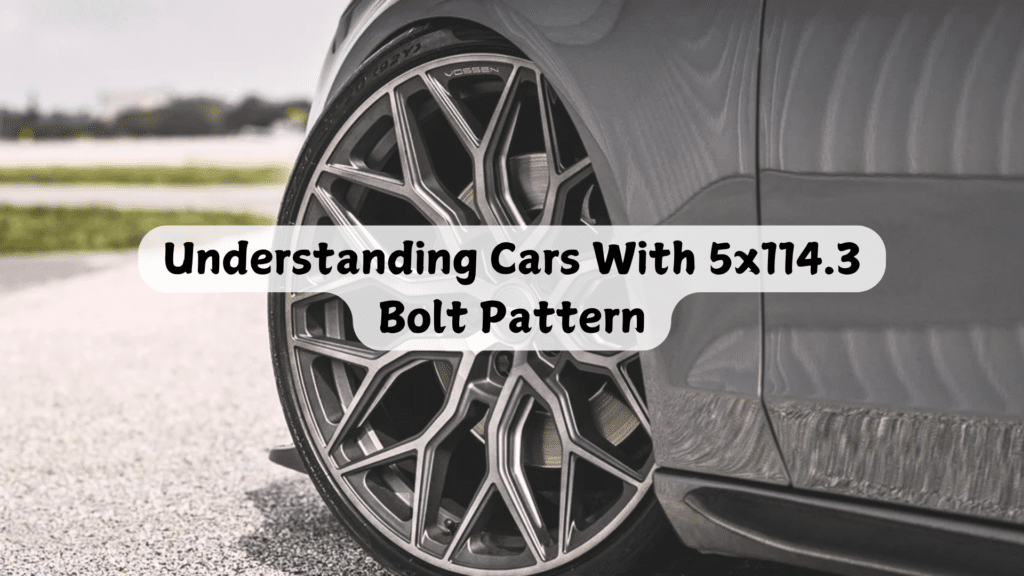Ever wonder why your car’s wheels have a specific set of holes?
These holes form a bolt pattern, the arrangement of lug holes that connect your wheels to your car.
Among the many patterns, the 5×114.3 pattern is one of the most common.
This post will break down everything about the 5×114.3 bolt pattern.
You’ll learn which cars use this pattern, why it’s so popular, and what wheels will fit your vehicle.
You’re in the right place if you want to buy new wheels or better understand your car.
As a certified auto technician with 15 years of experience working with various wheel configurations, I’ll help you understand this pattern completely.
By the end of this article, you’ll know exactly what options you have for your car’s wheels and how to make smart choices when shopping for them.
Understanding the 5×114.3 Bolt Pattern & Its Measurements

Let me explain 5×114.3 in simple terms.
When you see “5” in this pattern, it tells you the number of lug holes in your wheel.
The “114.3” shows the diameter of the circle these holes make, measured in millimeters.
Think of it like this: Place a ruler across your wheel from one lug hole to the opposite hole.
That distance of 114.3mm (or 4.5 inches) forms a circle that touches all five lug holes.
Getting these measurements right isn’t just about making wheels fit – it’s about keeping you safe.
Here’s why exact measurements matter:
- Wrong measurements can make your wheels wobble
- Loose-fitting wheels might come off while driving
- Poor fits can damage your wheel hub
- Incorrect patterns cause uneven tire wear
I recommend double-checking your measurements before buying new wheels.
A small mistake could cost you money and your safety.
You can find your bolt pattern in your car’s manual or measure it yourself with basic tools.
What Should Be Considered When Choosing Wheels for a 5×114.3 Bolt Pattern?
Let me help you pick the right wheels for your car.
Beyond matching the bolt pattern, there are three key things you need to check before buying.
1. Wheel Offset and Backspacing
The offset is how your wheel sits on the car – either pushed in or sticking out.
Here’s what you need to know:
- Positive offset pushes your wheel inward
- Zero offset puts it in the middle
- A negative offset makes it stick out
Getting this wrong could make your tires rub against your car’s body or affect your steering.
I suggest measuring your current wheels’ offset first.
2. Hub Bore Size
The hole in the middle of your wheel must match the hole in your car’s hub exactly.
If it’s too small, the wheel won’t fit, and if it’s too large, it might not center properly.
Quick Tip: If your wheel’s center hole is bigger than your car’s hub, you can use hub-centric rings.
These metal rings fill the gap and keep everything centered.
3. Wheel Materials Matter
You have two main choices:
Alloy Wheels:
- Lighter weight
- Better cooling for your brakes
- More style options
- Cost more
Steel Wheels:
- Stronger
- Less likely to crack
- Better for rough roads
- Cost less
Remember: lighter wheels help your car perform better, but they might not be the best choice if you often drive on rough roads.
How Do You Install Wheels on Cars That Use a 5×114.3 Bolt Pattern?
Before we start, here are the tools you’ll need:
- A lug wrench or socket set
- Car jack
- Jack stands
- Torque wrench
- Wire brush
- Anti-seize compound
- Work gloves
- Wheel chocks
Step 1: Getting Your Car Ready
Park your car on flat ground.
Put wheel chocks behind the wheels that will stay on the ground.
This will keep your car from rolling.
Loosen the lug nuts slightly before lifting the car—it’s easier this way.
Step 2: Lifting The Car
Find the right spot under your car for the jack.
Check your manual if you’re not sure where.
Lift the car until the wheel is off the ground. Put jack stands under the car for safety.
Never work under a car that’s only held up by a jack.
Step 3: Removing The Old Wheel
Take off all lug nuts and remove the old wheel.
Clean the hub surface with your wire brush.
Check for any damage or rust while you’re at it.
Step 4: Putting On The New Wheel
Line up the holes in your new wheel with the studs on your car.
Put it on carefully – these wheels can be heavy.
Put the lug nuts on by hand first.
Make them snug but not too tight.
Step 5: Final Steps
Lower the car until the wheel touches the ground, but the car’s weight isn’t fully on it.
Now use your torque wrench to tighten the lug nuts properly.
Go in a star pattern – this helps the wheel sit evenly. Check your car’s manual for the right torque settings.
Safety Note: After driving 50-100 miles, check and tighten your lug nuts again.
They can come loose as everything settles in.
Common Mistakes to Avoid During Installation
1. Over-Tightening or Under-Tightening Lug Nuts
One of the biggest mistakes I see in my shop is people cranking lug nuts as tight as they can.
Your lug nuts need just the right amount of force – not too much, not too little.
Too tight? You’ll strip the threads or warp your rotors.
Too loose?
Your wheel might come off while driving.
Get yourself a torque wrench – they’re not expensive and will save you from costly repairs.
2. Using the Wrong Hardware
I’ve seen folks try to make the wrong lug nuts work because they were in a hurry.
Each wheel needs specific lug nuts designed for it.
Using the wrong ones is like wearing shoes that don’t fit – they’ll cause problems.
If your wheel needs spacers, make sure they’re the right thickness and made for your car.
Mixing and matching parts might seem fine at first, but it can lead to serious problems later.
3. Ignoring Manufacturer Guidelines
Your car’s manual isn’t just taking up space in your glove box – it has important information about your wheels.
Each car model has specific torque settings and installation steps.
Skipping these guidelines might seem like a shortcut, but it often leads to problems.
Follow the manual’s torque specs and tightening pattern.
These numbers weren’t picked randomly – they’re what your car needs to run safely.
4. Forgetting to Re-torque
Many people skip this step, but it’s crucial.
You need to check and adjust the torque after driving 50-100 miles with new wheels.
Your wheels settle in as you drive, which can make the lug nuts looser than they should be.
This quick check can prevent bigger problems later.
5. Poor Surface Preparation
The surface where your wheel meets the hub needs to be clean.
Rust, dirt, or old paint can stop your wheel from sitting flat.
Take five minutes to clean both surfaces with a wire brush.
This small step makes a big difference in how well your wheels work and how long they last.
Applications of the 5×114.3 Bolt Pattern in Different Vehicles
| Vehicle Type | Popular Models | Years | Notes |
|---|---|---|---|
| Sports Cars | Honda S2000 | 2000-2009 | Common in street racing |
| Nissan 350Z | 2003-2009 | Strong aftermarket support | |
| Subaru WRX | 2015-2024 | Popular for modifications | |
| Family Sedans | Honda Accord | 2003-2024 | Wide wheel options |
| Toyota Camry | 1992-2024 | Easy to find replacements | |
| Nissan Altima | 2002-2024 | Good parts availability | |
| SUVs | Honda CR-V | 2007-2024 | Fits many wheel styles |
| Toyota RAV4 | 2006-2024 | Works well with all-terrain tires | |
| Jeep Cherokee | 2014-2024 | Good for mild off-roading | |
| Light Trucks | Toyota Tacoma | 2005-2024 | Strong load capacity |
| Nissan Frontier | 2005-2024 | Works with bigger tires | |
| Honda Ridgeline | 2006-2024 | Good for daily use | |
| Minivans | Honda Odyssey | 2005-2024 | Smooth ride focus |
| Toyota Sienna | 2004-2024 | Comfort-oriented setup |
Benefits of the 5×114.3 Bolt Pattern
1. Wide Availability
Having worked with various bolt patterns, I can tell you that 5×114.3 gives you the most options.
You’ll find wheels in all sizes, styles, and price ranges.
When your tire shop doesn’t have what you want, you can easily order online or check other stores.
Most major wheel makers produce 5×114.3 options, so you’re not stuck with just a few choices.
This means better prices, too – more competition keeps costs reasonable.
2. Versatility
This pattern works well on many different vehicles, from small cars to bigger SUVs.
5×114.3 handles various weights and driving conditions well.
You can switch wheels between cars that use this pattern.
For example, if you own a Honda and a Toyota with the same bolt pattern, you could use the same winter wheels on either car.
3. Ease of Upgrading
This bolt pattern makes it simple when you want to improve your car’s look or performance.
You can:
- Find racing wheels easily
- Switch between different wheel sizes
- Try various wheel widths
- Choose from many brake upgrade kits
- Use spacers if needed
4. Strong and Reliable
The five-lug design spreads weight evenly across your wheel.
This makes it strong enough for most cars and light trucks.
You won’t need special tools or hard-to-find parts for maintenance.
Most tire shops have everything needed to work on these wheels.
5. Cost-Effective
Because so many cars use this pattern, parts are easy to find and usually cost less.
You won’t pay extra for rare or special-order items.
Used wheels are also widely available if you’re on a budget.
List of Vehicles Using 5×114.3 Bolt Pattern
| Brand | Model | Years | Special Notes |
|---|---|---|---|
| Nissan | 350Z | 2003-2009 | All trims included |
| 370Z | 2009-2020 | Factory fitment | |
| Maxima | 2000-2024 | All models | |
| Honda | Accord | 2003-2024 | Except for some base models |
| Civic Type R | 2017-2024 | Some need adapters | |
| CR-V | 2007-2024 | All trims | |
| Toyota | Camry | 1992-2024 | V6 models standard |
| RAV4 | 2006-2024 | All versions | |
| Highlander | 2008-2024 | Except for some base models | |
| Ford | Mustang | 1994-2024 | GT models standard |
| Fusion | 2010-2020 | Sport models only | |
| Edge | 2007-2024 | All trims | |
| Mazda | Mazda6 | 2003-2024 | All models |
| CX-5 | 2013-2024 | Standard fit | |
| CX-9 | 2007-2024 | All versions | |
| Subaru | WRX | 2015-2024 | Including STI |
| Legacy | 2010-2024 | All trims | |
| Outback | 2010-2024 | All models |
Important Note: Always check your specific car’s manual or measure your bolt pattern yourself.
Some models changed patterns between years or trim levels.
Conclusion
Let’s wrap up what we’ve learned about the 5×114.3 bolt pattern.
This pattern’s widespread use across many car brands makes it a practical choice for wheel options.
Remember: correct measurements and proper installation keep you safe on the road.
When working with your wheels, take time to:
- Measure your bolt pattern twice
- Clean all mounting surfaces
- Check your lug nuts after 50-100 miles
In my years as a mechanic, I’ve seen many wheels come and go, but the 5×114.3 pattern remains a solid choice.
If you still have questions about your car’s bolt pattern or need help choosing wheels, consult your owner’s manual or ask a trusted mechanic.
Frequently Asked Questions
Can I Use Wheel Spacers with a 5×114.3 Bolt Pattern?
Yes, you can use wheel spacers, but they must match your bolt pattern.
For safety, always buy quality spacers and have them professionally installed.
How Much Does Wheel Offset Matter for Daily Driving?
For daily driving, stick within 5-10mm of your factory offset.
Going too far from stock specs can stress your bearings and affect handling.
Does Weather Affect My Wheel’s Bolt Pattern Tightness?
Temperature changes can affect lug nut tightness.
In areas with extreme temperature swings between seasons, check your wheels’ torque settings more often.


